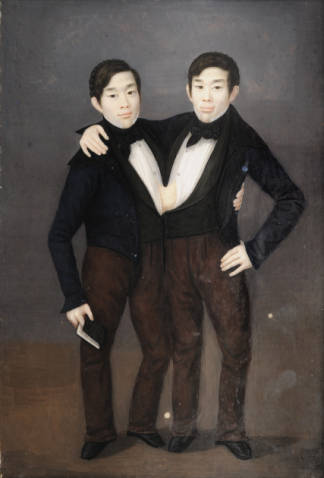The original “Siamese Twins”
Born in Siam (now Thailand) in 1811, Eng and Chang Bunker were connected at the chest by a five-inch-wide band of flesh. The location of this connection suggested to some doctors and other observers that the brothers shared a heart or some respiratory functions. These medical assumptions would be proven wrong. According to their biography, the twins shared relatively “normal” boyhoods in Siam, running and playing with other children, doing chores, and helping to support their parents and siblings by gathering and selling duck eggs in their small village.
Later, as teenagers, the twins left Siam and began a career traveling with two agents, Robert Hunter and Abel Coffin. Eng and Chang earned money by giving lectures and demonstrations throughout the United States, Canada, South America, and Europe. In fact, entries in their travel-expense journal, documents that they visited the campus of the University of North Carolina at Chapel Hill in October, 1834. In their far-flung travels, Eng and Chang became such popular celebrities during the 1830s that their promotion as “Siamese twins” were terms that were universally employed to describe connected or conjoined twins.
By the late 1830s, Eng and Chang tired of all their traveling, opting then to settle in North Carolina. There the brothers married two sisters, Adelaide and Sarah Yates of Wilkes County. The sisters were of European ancestry and were neither twins nor connected themselves. The couples were married in 1843 and would ultimately produce 21 children between the two families. Eng and Chang died in January, 1874, at the age of 63. Chang preceded Eng in death by about two and a half hours. An autopsy indicated that Chang died of a blood clot in the brain; and at the time Eng’s demise was attributed, understandably, to shock. The image featured above is an original watercolor on ivory depicting the twins, and it was painted by an unidentified French or Dutch artist in Paris between December, 1835 and March, 1836. It is currently in the holdings of the North Carolina Collection Gallery.




